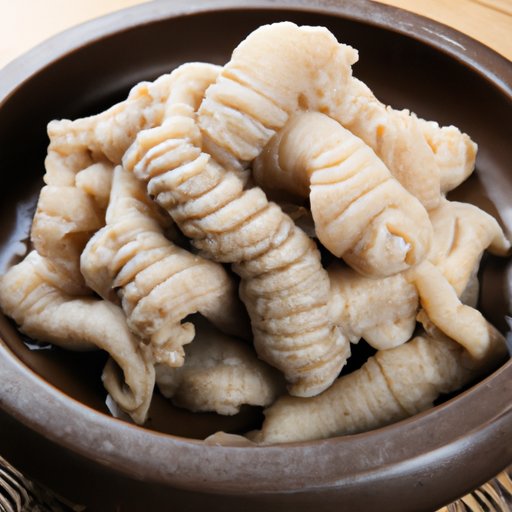Introduction
Tripe is a type of edible offal made from the stomach lining of cows, sheep, or pigs. It has a long history and is used in many different types of cuisine around the world. But what exactly is tripe and why should you include it in your diet? This article will explore the definition of tripe, its culinary journey, and its nutritional benefits.
Definition of Tripe
Tripe is the edible lining of the stomachs of animals such as cows, sheep, and pigs. It is usually cooked and served in a variety of dishes. Tripe is known for its chewy texture and rich flavor. The most common types of tripe are beef tripe, lamb tripe, and pork tripe.

Overview of Its History and Culinary Journey
Tripe has been consumed since ancient times. According to archaeological evidence, tripe was eaten by the Romans, Greeks, and Egyptians. In the Middle Ages, tripe became a popular food among peasants in Europe. During this time, the dish was often served with onions, garlic, and herbs. Tripe also gained popularity in Asia, where it is still eaten today.
Today, tripe is enjoyed by people all over the world. It is served in a variety of dishes, such as stews, soups, and curries. It can also be fried, grilled, or boiled. There are countless recipes featuring tripe, so you can easily find one that fits your taste.

Types of Tripe and How to Cook Them
There are three main types of tripe: beef tripe, lamb tripe, and pork tripe. Each type has its own distinct flavor and texture. Beef tripe is the most popular type of tripe and is often used in Mexican and Italian dishes. Lamb tripe is milder in flavor and is often used in Mediterranean dishes. Pork tripe is usually found in Asian dishes.
When it comes to preparing tripe, there are several steps to follow. First, it must be thoroughly washed and soaked. This helps to remove any impurities and improve the texture. Then, it must be boiled until tender. Once it has been cooked, tripe can be added to sauces, stews, soups, and other dishes.
Nutritional Benefits of Tripe
In addition to its delicious flavor, tripe is also a great source of nutrition. It is packed with vitamins and minerals, including iron, calcium, and B vitamins. Tripe is also high in protein and low in calories, making it an excellent choice for those looking to lose weight. In addition, research suggests that tripe may have anti-inflammatory and antioxidant properties, which can help to boost the immune system.
According to a study published in the journal Nutrients, tripe is a good source of essential fatty acids and contains high amounts of conjugated linoleic acid (CLA), which is believed to have beneficial health effects. The study concluded that regular consumption of tripe could help to reduce inflammation and improve overall health.
Origin and Uses of Tripe
Tripe has been eaten for centuries and has a long history. It is believed to have originated in ancient Egypt, where it was a staple food of the Pharaohs. In Europe, tripe was a popular dish among peasants during the Middle Ages. Today, tripe is still enjoyed around the world and is used in many traditional dishes.
In addition to its culinary uses, tripe is also used in a variety of non-food products. For example, it is commonly used in leather goods, such as wallets and bags. It is also used in medical products, such as surgical sutures. Finally, tripe is used as fertilizer in some parts of the world.

Delicious Recipes from Around the World
Tripe is a versatile ingredient that can be used in a variety of dishes. Here are some delicious recipes from around the world that feature tripe:
Asian Dishes: In China, tripe is often stir-fried with vegetables and spices. In Japan, it is commonly served in a hot pot. In Thailand, it is stewed with coconut milk and spices.
European Dishes: In Italy, tripe is served in a sauce of tomatoes, onions, and herbs. In France, it is slow-cooked with wine and vegetables. In Spain, it is often stewed with chorizo and potatoes.
African Dishes: In Ethiopia, tripe is simmered with berbere spice and served with injera flatbread. In Morocco, it is cooked with chickpeas and spices. In South Africa, it is braised with tomato sauce and served with pap.
Conclusion
Tripe is a unique type of meat that has been enjoyed for centuries. It is an excellent source of nutrition and can be used in a variety of dishes. From Asian stir-fries to European stews, tripe adds a rich flavor and chewy texture to any meal. So the next time you’re looking for something new to cook, consider giving tripe a try!
In summary, tripe is a nutritious and flavorful food that has a long history. It is packed with vitamins and minerals, and is low in calories and high in protein. Plus, it can be used in a variety of dishes from all around the world.
(Note: Is this article not meeting your expectations? Do you have knowledge or insights to share? Unlock new opportunities and expand your reach by joining our authors team. Click Registration to join us and share your expertise with our readers.)
